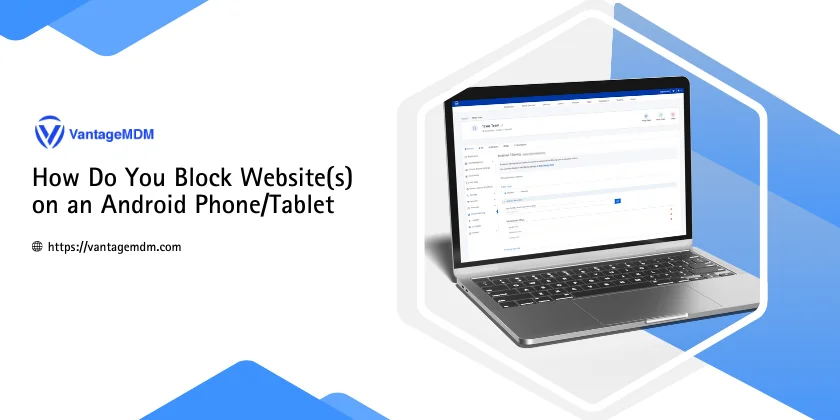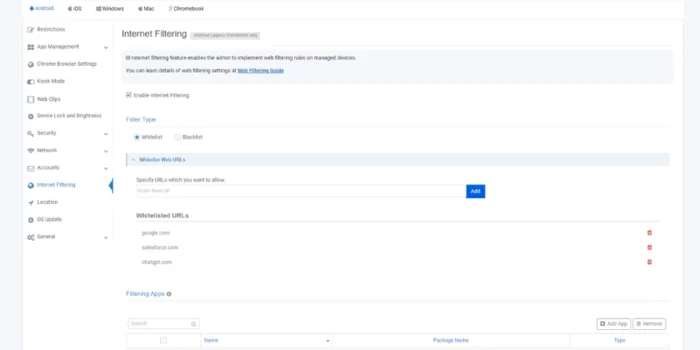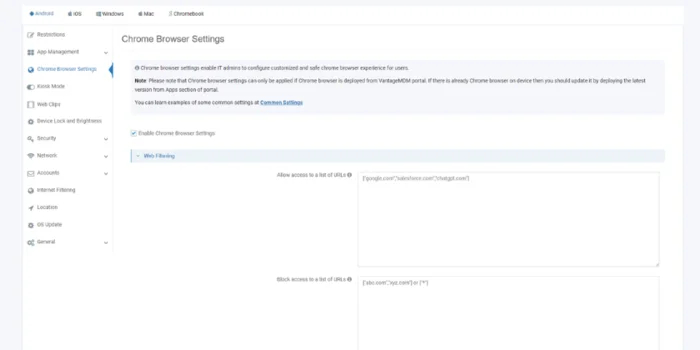How Do You Block Website(s) on an Android Phone/Tablet?

Access to websites can be crucial for productivity and learning, but certain sites can also be a distraction or inappropriate, especially for children or workplace devices. Android devices offer multiple ways to manage and control website access, helping you ensure secure browsing or enforce limitations as needed.
There are effective, built-in options for website blocking on Android phones and tablets, as well as advanced management solutions if you’re looking to manage multiple devices, such as through VantageMDM. Here’s a detailed guide on different ways to block websites on Android.
Block Website(s) on Android Phone and Tablet Effortlessly
-
Using Google Family Link (for Child Accounts):
-
Google Family Link lets parents manage their child’s device and restrict specific content.
-
Go to Settings > Digital Wellbeing & parental controls > Set up parental controls.
-
Install Family Link on your device, set up a child’s account, and manage website restrictions through Family Link.
-
Websites can be blocked or restricted through this parental control setting.
-
-
Setting Up Restricted Mode in Google Chrome:
-
Chrome’s SafeSearch and Restricted Mode can help filter out explicit content.
-
Open Chrome on the device, go to Settings > Privacy and Security > SafeSearch.
-
Turn on SafeSearch to prevent access to explicit content, helping to block some types of inappropriate sites.
-
-
Modifying the Hosts File (For Advanced Users):
-
Android devices store a hosts file in their system folder, which can be modified to block specific websites.
-
Accessing and editing this file usually requires root access (often needing third-party tools), but some file managers on certain Android versions may allow it.
-
Add the website address and redirect it to 127.0.0.1, blocking specific domains.
-
Example entry: 127.0.0.1 www.example.com
-
-
Using Google SafeSearch (Via Google Account):
-
Go to myaccount.google.com on any browser, then navigate to Data & Personalization > Web & App Activity.
-
Turn on SafeSearch to restrict adult content.
-
While it doesn’t block specific URLs, it filters explicit sites, limiting certain types of inappropriate content.
-
-
Router-Based Blocking (If Using Wi-Fi):
-
Most Wi-Fi routers allow you to block specific websites or categories of sites.
-
Access your router’s admin panel (often by typing 192.168.0.1 or 192.168.1.1 in a browser).
-
Look for Parental Controls or Access Restrictions to block specific URLs.
-
This method works only when the device is connected to the same Wi-Fi network.
-
-
Enabling Private DNS (on Android 9 or above):
-
Go to Settings > Network & Internet > Advanced > Private DNS.
-
Set up Private DNS using a DNS provider that offers content filtering (such as CleanBrowsing, OpenDNS, or Quad9).
-
Example: Choose dns-family.adguard.com as the Private DNS provider, blocking access to adult sites.
-
-
Turning Off Web Browsing Access Entirely for Certain Apps (If Necessary):
-
You can restrict app usage using the Digital Wellbeing tool on Android to limit access to browsers.
-
Go to Settings > Digital Wellbeing & parental controls and set limits on internet browsing apps.
-
-
Using VantageMDM:
-
VantageMDM offers robust website blocking capabilities, making it easy to manage access across multiple Android devices. Here’s how to set it up:
-
Access VantageMDM Console: Open the VantageMDM dashboard and navigate to the Policies section.
-
Configure Internet Filtering:
-
Under Android policies, select Internet Filtering. Enable Internet Filtering, then select either the Blacklist or Whitelist option:
-
Blacklist: Choose Blacklist to restrict access to specific websites by listing URLs you want to block.
-
Whitelist: To ensure only specific websites are accessible, choose Whitelist and add only the URLs you want to allow. This will block all other sites.
-
-
Steps for Whitelisting:
-
Click on Policies, under Android, then select Internet Filtering.
-
Choose Whitelist after enabling Internet Filtering.
-
Add the URLs to whitelist, ensuring that no other websites can be accessed.
-
Save and Publish settings.

-
-
Configure Whitelisting for Chrome Browser:
-
-
You can even configure URL whitelisting specifically for the Chrome browser.
-
Go to Chrome Browser Settings under Internet Filtering and add the list of URLs to whitelist.
-
-

Also read: How to Whitelist Websites on Multiple Operating Systems with VantageMDM
Why Block Websites on Android Devices?
Controlling access to certain websites on Android devices is essential in various scenarios, from ensuring online safety for children to enhancing productivity in professional environments. By blocking access to inappropriate or distracting sites, Android users can create a more focused and secure digital experience. Moreover, restricting website access is a proactive step to protect sensitive information and avoid exposure to harmful content.
Businesses and parents alike benefit from website blocking tools, as they allow for customized control over the browsing environment. Parents can shield their children from unsuitable material, while companies can maintain a productive workplace by preventing employees from accessing non-work-related sites during business hours. Each method varies in complexity and effectiveness, offering flexibility depending on specific needs and available resources.
These strategies are particularly useful for organizations managing multiple Android devices. Comprehensive solutions like VantageMDM make it easy to apply consistent internet restrictions across all devices within a network. Whether you choose native Android settings or a centralized management solution, there’s an option suited to every level of control and supervision